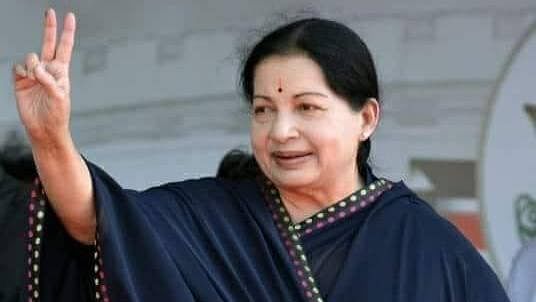Few Indian states match Tamil Nadu in its propensity to create larger than life heroes out of politicians. In the 1980s, the state saw the rise of its first such female leader who went on to get celebrated by her people and fellow statesmen as the ‘Iron butterfly’, a ‘Goddess’, a ‘Golden Star’ and ‘Puratchi Thalaivi’ (revolutionary leader). But the name that truly stuck for the late chief minister and AIADMK supremo Jayalalithaa was ‘Amma’ (mother).
ThePrint takes a look at her journey from being an actress to holding the chief minister’s chair for six terms.
Relationship with MGR
Born on 24 February, 1948, Jayalalithaa was introduced to the film industry at a very young age by her actress mother. However, she shot to fame with the role of a young bride opposite superstar M.G. Ramachandran in Aayirathil Oruvan (1965) at the age of 15. After over a decade, she joined MGR’s party AIADMK in 1982 buoyed by his support. But her relationship with MGR, whom she dubbed as her political mentor, was far from being smooth.
Initially, though Jayalalithaa was introduced to her political career by MGR, the two didn’t always share a warm relationship. The two were rumoured to have held a tumultuous relationship, with MGR allegedly being suspicious of her moves as he felt she was too independent. She was aware of this and also felt ‘trapped’ by it, said an Outlook report quoting writer Valampuri John. She sought a new friendship with Telugu star Shoban Babu when MGR featured new heroines in his films in 1970s.
The cold war lasted almost a decade till 1981. However, she joined AIADMK a year later.
In 1984, their relationship again took a turn again when MGR stripped her of her status as a Rajya Sabha MP as he suspected that she wanted to be chief minister and to take over the party reins while he recuperated outside the country.
Over this, she ensured the world got to see her anger and her want for independence.
“MGR has been a great influence in my life, I don’t deny that. But now I am my own person. I have evolved. Hereafter, I am responsible only for myself. Never again will anybody influence me to such an extent that all my thoughts and actions and statements are influenced and made in a particular way just because someone else wants it that way,” she was quoted as saying.
Following this rift, a party by the name Jayalalitha Peravai (conference) was formed though Jaya denied any knowledge of it, according to Manorama. This upset MGR greatly and she was officially removed as the propaganda secretary of AIADMK, a post that was created for her.
However, when MGR realised that his protege might break away to form her own faction with the support of 33 MLAs, he invited her to speak at a public rally in what became a turning point for her.
Following MGR’s death in 1987, MGR’s wife Janaki became the chief minister. After a split in the party in 1989, the President’s rule was imposed in Tamil Nadu for 21 days but Jayalalithaa wrested power from Janaki and became an unchallenged monolith.
Also read: Rajkumari Amrit Kaur, the princess who was Gandhi’s secretary & India’s first health minister
Winning hearts
Jayalalithaa grew in popularity and fame as she gained sympathy from people due to several incidents that affected her.
On 25 March, 1989, she was assaulted in the Tamil Nadu assembly by DMK minister Durai Murugan. In the tussle, her saree was torn and her hair pulled. While she was the opposition leader at the time, she left the assembly vowing to be back as a chief minister.
An iconic image of her walking out of the assembly in disheveled hair with a hand placed on her head won her waves of sympathy. However, a redefining image clicked by an Indian Express photographer, Sivaraman, of her looking on through her torn saree featured on the front page the next day, changing the course of Tamil Nadu politics for good.
In 1991, she completed her vow to return to the assembly as chief minister.
Also read: Remembering Sarojini Naidu, India’s nightingale who endeared millions with her words
Corruption cases
Despite being the dominant political figure in Tamil Nadu, Jayalalithaa faced several corruption cases. In 1996, she was briefly jailed too over irregularities related to purchase of 45,000 television sets during her first term as CM.
Another corruption case raid at her residence in 1996 at Poes Garden in Chennai and in Hyderabad revealed valuables and documents worth Rs 58 crore.
That apart, ‘jewellery — 30 kg of gold (400 pairs of bangles) and 500 kg of silver — over 100 wrist watches, more than 150 curios and semi-precious stones, besides a wardrobe of 10,000 saris and 250 pairs of imported footwear’ were also found, said an India Today report.
She served as chief minister for six terms before her untimely death on 5 December, 2016, but the cases against her are from over. Her close friend and political aide Sasikala currently is still serving in jail in a disproportionate assets case in which Jayalalithaa was also a co-accused.
Her death over two years ago sent the political machinery in Tamil Nadu crumbling with AIADMK factions fighting to own her legacy. The vacuum she left behind both as a politician and a chief minister still persists.



